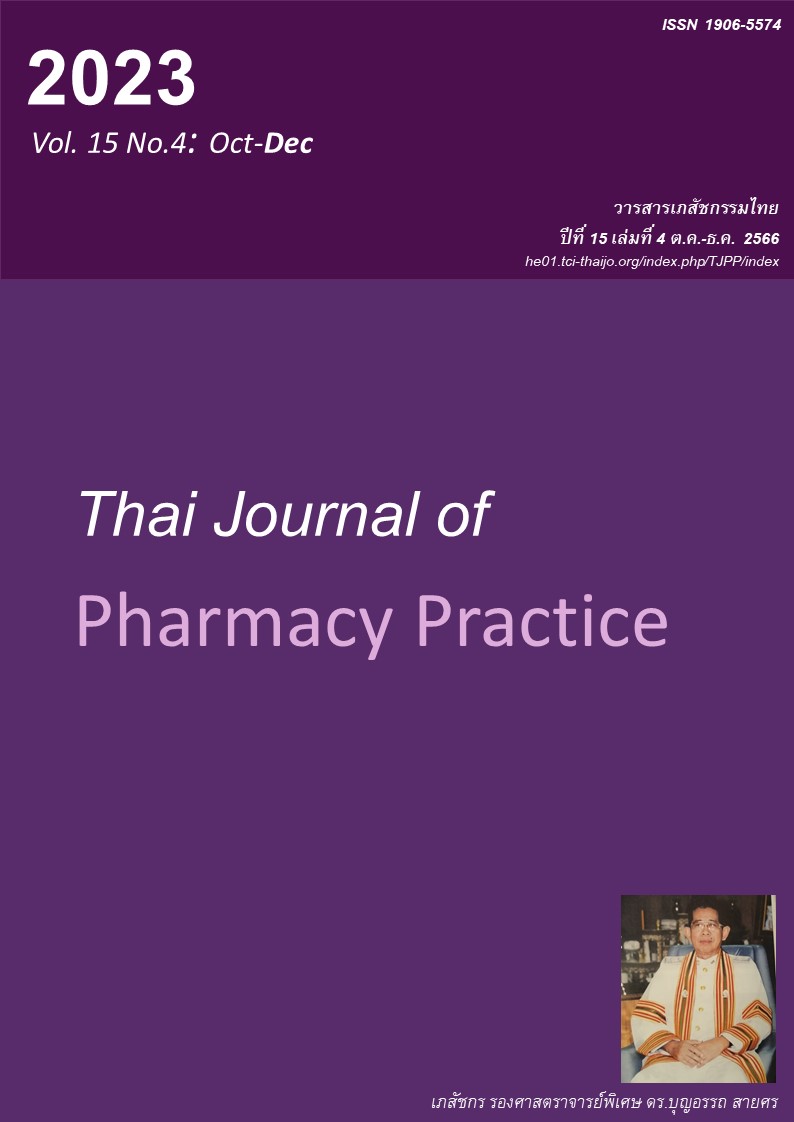การใช้วิธีการเปรียบเทียบสายอักขระแบบประมาณในการตรวจสอบ ชื่อผลิตภัณฑ์เครื่องสำอางในแบบคำขอจดแจ้งเครื่องสำอาง
Main Article Content
บทคัดย่อ
วัตถุประสงค์: เพื่อพัฒนาโปรแกรมสำหรับการตรวจสอบชื่อผลิตภัณฑ์เครื่องสำอางในแบบคำขอจดแจ้งเครื่องสำอางด้วยวิธีการเปรียบเทียบสายอักขระแบบประมาณโดยการหาระยะทางเลเวนชเตย์น และประเมินประสิทธิภาพของโปรแกรมโดยเปรียบเทียบผลการพิจารณาชื่อผลิตภัณฑ์เครื่องสำอางกับผลการพิจารณาโดยเจ้าหน้าที่ผู้เชี่ยวชาญ วิธีการ: กรอบแนวคิดในการพัฒนาโปรแกรมอยู่บนพื้นฐานของทฤษฎีวงจรการพัฒนาระบบ ปัญหาของการตรวจสอบชื่อผลิตภัณฑ์เครื่องสำอางได้ถูกวิเคราะห์พบว่ามี 2 ปัญหา คือ ความล่าช้าและความคลาดเคลื่อนในการตรวจสอบ โปรแกรมประยุกต์บนเว็บสำหรับตรวจสอบชื่อผลิตภัณฑ์เครื่องสำอางได้ถูกพัฒนาขึ้น อัลกอริทึมหลักของโปรแกรมประยุกต์นี้คือการเปรียบเทียบสายอักขระแบบประมาณโดยการหาระยะทางเลเวนชเตย์น การประเมินประสิทธิภาพของโปรแกรมพิจารณาจากค่า F1 ผลการวิจัย: การใช้เทคนิค n-gram ในการกำหนดคุณลักษณะของคำเพื่อเพิ่มประสิทธิภาพในการเปรียบเทียบสายอักขระ พบว่า คุณลักษณะของคำที่เหมาะสมกับงานวิจัยนี้คือ รูปแบบ trigram กำหนดค่า threshold ของความคล้ายคลึงกันของสายอักขระที่ 80, 85 และ 90 การกำหนดค่า threshold 80 หมายถึง สายอักขระสองชุดซึ่งมีความคล้ายคลึงกันมากกว่าหรือเท่ากับร้อยละ 80 จะกำหนดว่าเป็นสายอักขระชุดเดียวกัน ในการเปรียบเทียบประสิทธิภาพของโปรแกรมโดยใช้เครื่องมือตัดคำภาษาไทยทั้ง 8 วิธี เครื่องมือตัดคำที่มีประสิทธิภาพสูงสุดเมื่อกำหนดค่า threshold เป็น 85 และ 90 คือ attacut และ tltk ตามลำดับ ไม่พบความแตกต่างกันอย่างมีนัยสำคัญทางสถิติเมื่อเปรียบเทียบผลการพิจารณาชื่อผลิตภัณฑ์เครื่องสำอางกับผลการพิจารณาโดยเจ้าหน้าที่ผู้เชี่ยวชาญ สรุป: โปรแกรมถูกใช้เพื่อการตรวจสอบชื่อผลิตภัณฑ์เครื่องสำอางในแบบคำขอจดแจ้งเครื่องสำอางด้วยวิธีการเปรียบเทียบสายอักขระแบบประมาณ ผลการพิจารณาชื่อผลิตภัณฑ์เครื่องสำอางมีความถูกต้องและเป็นไปในทิศทางเดียวกันกับการพิจารณาโดยผู้เชี่ยวชาญ จึงสามารถนำไปใช้เพื่อสนับสนุนเจ้าหน้าที่ในการตรวจสอบข้อมูลในแบบคำขอจดแจ้งเครื่องสำอางเบื้องต้น
Article Details

อนุญาตภายใต้เงื่อนไข Creative Commons Attribution-NonCommercial-NoDerivatives 4.0 International License.
ผลการวิจัยและความคิดเห็นที่ปรากฏในบทความถือเป็นความคิดเห็นและอยู่ในความรับผิดชอบของผู้นิพนธ์ มิใช่ความเห็นหรือความรับผิดชอบของกองบรรณาธิการ หรือคณะเภสัชศาสตร์ มหาวิทยาลัยสงขลานครินทร์ ทั้งนี้ไม่รวมความผิดพลาดอันเกิดจากการพิมพ์ บทความที่ได้รับการเผยแพร่โดยวารสารเภสัชกรรมไทยถือเป็นสิทธิ์ของวารสารฯ
เอกสารอ้างอิง
Marketeer team. Beauty market in 2022 with beauty tech: a case study of L'Oreal [online]. 2022 [cited Sep 21, 2022]. Available from: marketeeronline.co/ archives/266777.
Department of Trade Negotiation, Ministry of Commerce. Thailand cosmetic market: plans for preference utilization in FTAs to increase exports [online]. 2021 [cited Sep 21, 2022]. Available from: www.dtn.go.th/th/news/607e50d7ef4140b573032f4 0?cate=5cff753c1ac9ee073b7bd1c5.
Cosmetic Act B.E. 2558. Royal Gazette No. 132, Part 86A (Sep 8, 2015).
Juntarawongpaisarn K, Ruengorn C. Situation of cosmetic notification on e-Submission and moni- toring of Thai Food and Drug Administration, fiscal year 2016-2019. Thai Food and Drug Journal 2021; 28: 60-71.
Cosmetic Control Group, Food and Drug Adminis- tration. Thailand cosmetic regulation guidelines (updated 2021) [online]. 2021 [cited Jan 9, 2022]. Available from: www.fda.moph.go.th/sites/Cosmetic /PublishingImages/SitePages/Permission/29-6-65-Update.pdf.
Navarro G. A guided tour to approximate string matching. ACM Comput Surv 2001; 33: 31-88.
Watcharapinchai N, Rujikietgumjorn S. Approximate license plate string matching for vehicle re-identifi- cation. 2017 14th IEEE International Conference on Advanced Video and Signal Based Surveillance (AVSS); 2017 Aug 29 - Sep 1; Lecce, Italy: IEEE; 2017. p. 1-6.
Levenshtein VI. Binary codes capable of correcting deletions, insertions, and reversals. Sov Phys Dokl 1966; 10: 707-10.
Yulianto MM, Arifudin R, Alamsyah A. Autocomplete and spell checking Levenshtein distance algorithm to getting text suggest error data searching in library. Sci J Inform 2018; 51: 67-75.
Haldar R, Mukhopadhyay D. Levenshtein distance technique in dictionary lookup methods: an improved approach [online]. 2011 [cited Dec 15, 2021]. Available from: arxiv.org/ftp/arxiv/papers/1101/1101. 1232.pdf
Santirattanaphakdi C, Niwattanakul S. The design and development of public bus complaint classifica tion process for service problem tagging. Journal of Engineering and Digital Technology 2021; 9: 77-91.
Paluekpet T. Applying Levenshtein’s algorithm to find homograph and look-alike herb names [master thesis]. Nakhon Pathom: Silpakorn University; 2017.
Urathamakun P, Runapongsa K. Improved rule-based and new dictionary for Thai word segmen- tation. The 3rd Joint Conference on Computer Science and Software Engineering; 2006 June 28-30; Bangkok, Thailand. 2006. p. 34-40.
Ekwonganan A. Identification of Thai and translite- rated words by n-gram models [master thesis]. Bangkok: Chulalongkom University; 2005.
Connor RJ. Sample size for testing differences in proportions for the paired-sample design. Biome- trics. 1987; 43: 207-11.
Aiumsiriwong O. System analysis and design. Bang kok: Se-Education; 2012.
Supaartagorn C. Web application development with PHP and MySQL+AJAX jQuery. 2nd ed. Bangkok: Simplify Press; 2018.
Wichitbunyarak P. HMTL: a web language. Execu- tive Journal 2011; 3: 203-7.
Phatthiyaphaibun W, Chaovavanich K, Polpanumas C, Suriyawongkul A, Lowphansirikul L, Chormai P. PyThaiNLP: Thai natural language processing in python [online]. 2016 [cited Jun 27, 2022]. Available from: doi.org/10.5281/zenodo.3519354.
Parikh N, Singh G, Sundaresan N. Query sugges- tion with large scale data. In: Govindaraju V, Rao CR, editors. Handbook of statistics machine learning : theory and applications. Vol. 31. Amsterdam: Elsevier; 2013. p. 493-518.
Kumar G. Evaluation metrics for intrusion detection systems-a study. Int J Comput Sci Mob Appl 2014; 2: 11-7.
Somprasertsri G. Automatic Thai keyphrase extrac- tion using n-gram and machine learning approach. Journal of Information Science 2014; 32: 111-28.


